Testing The World’s Best APUs: Desktop AMD Ryzen 4750G, 4650G and 4350G
by Dr. Ian Cutress on December 16, 2020 10:30 AM ESTCPU Benchmarks: Real World
All of our benchmark results can also be found in our benchmark engine, Bench.
Agisoft Photoscan 1.3.3: link
The concept of Photoscan is about translating many 2D images into a 3D model - so the more detailed the images, and the more you have, the better the final 3D model in both spatial accuracy and texturing accuracy. The algorithm has four stages, with some parts of the stages being single-threaded and others multi-threaded, along with some cache/memory dependency in there as well. For some of the more variable threaded workload, features such as Speed Shift and XFR will be able to take advantage of CPU stalls or downtime, giving sizeable speedups on newer microarchitectures.
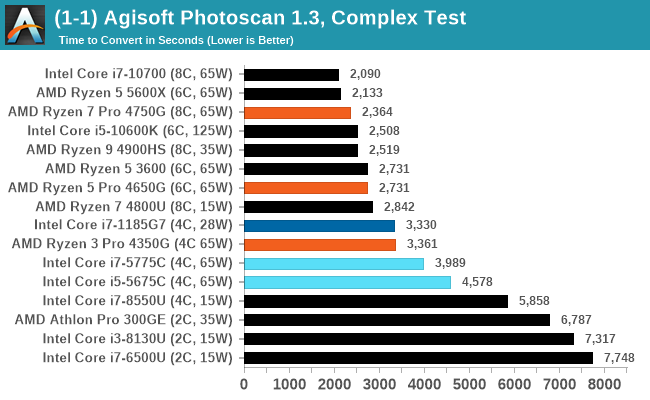
NAMD 2.13 (ApoA1): Molecular Dynamics
One of the popular science fields is modeling the dynamics of proteins. By looking at how the energy of active sites within a large protein structure over time, scientists behind the research can calculate required activation energies for potential interactions. This becomes very important in drug discovery. Molecular dynamics also plays a large role in protein folding, and in understanding what happens when proteins misfold, and what can be done to prevent it. NAMD, or Nanoscale Molecular Dynamics, has already been used in extensive Coronavirus research on the Frontier supercomputer. Typical simulations using the package are measured in how many nanoseconds per day can be calculated with the given hardware, and the ApoA1 protein (92,224 atoms) has been the standard model for molecular dynamics simulation.
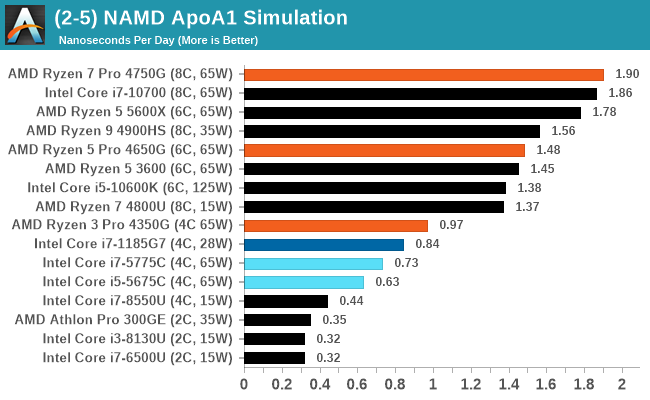
Blender 2.83 LTS: Link
One of the popular tools for rendering is Blender, with it being a public open source project that anyone in the animation industry can get involved in. This extends to conferences, use in films and VR, with a dedicated Blender Institute, and everything you might expect from a professional software package (except perhaps a professional grade support package). With it being open-source, studios can customize it in as many ways as they need to get the results they require. It ends up being a big optimization target for both Intel and AMD in this regard.
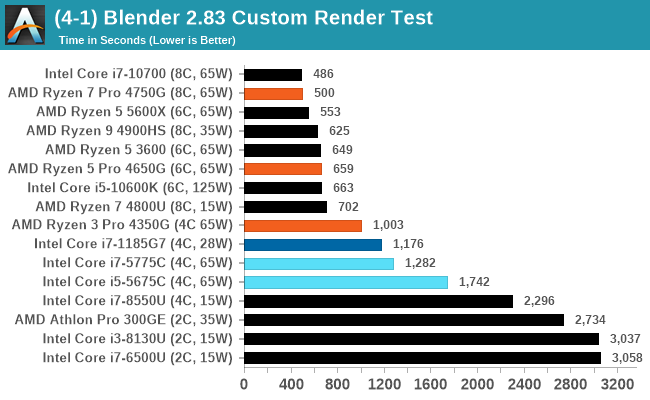
Corona 1.3: Link
Corona is billed as a popular high-performance photorealistic rendering engine for 3ds Max, with development for Cinema 4D support as well. In order to promote the software, the developers produced a downloadable benchmark on the 1.3 version of the software, with a ray-traced scene involving a military vehicle and a lot of foliage.
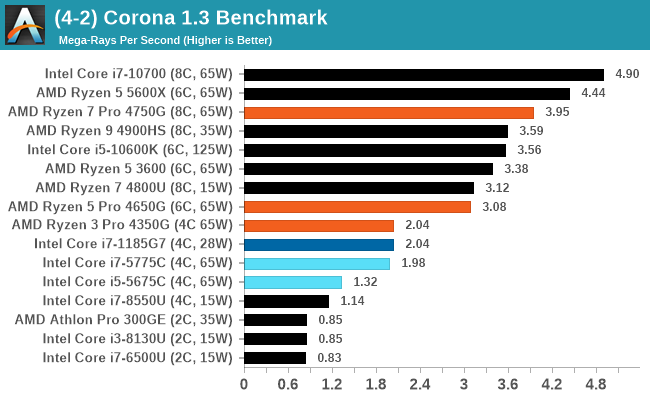
POV-Ray 3.7.1: Link
A long time benchmark staple, POV-Ray is another rendering program that is well known to load up every single thread in a system, regardless of cache and memory levels. After a long period of POV-Ray 3.7 being the latest official release, when AMD launched Ryzen the POV-Ray codebase suddenly saw a range of activity from both AMD and Intel, knowing that the software (with the built-in benchmark) would be an optimization tool for the hardware.
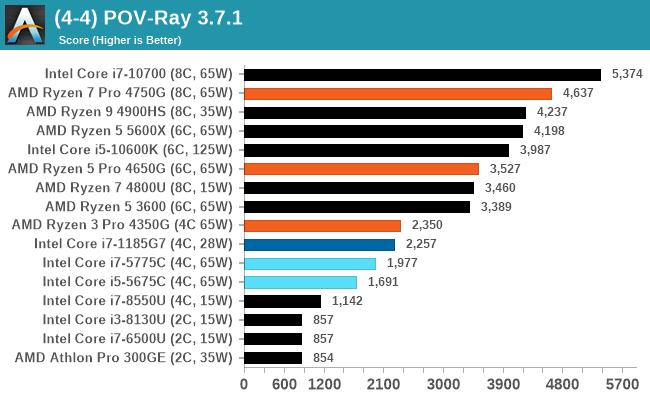
V-Ray: Link
We have a couple of renderers and ray tracers in our suite already, however V-Ray’s benchmark came through for a requested benchmark enough for us to roll it in. Built by ChaosGroup, V-Ray is a 3D rendering package compatible with a number of popular commercial imaging applications, such as 3ds Max, Maya, Undreal, Cinema 4D, and Blender.
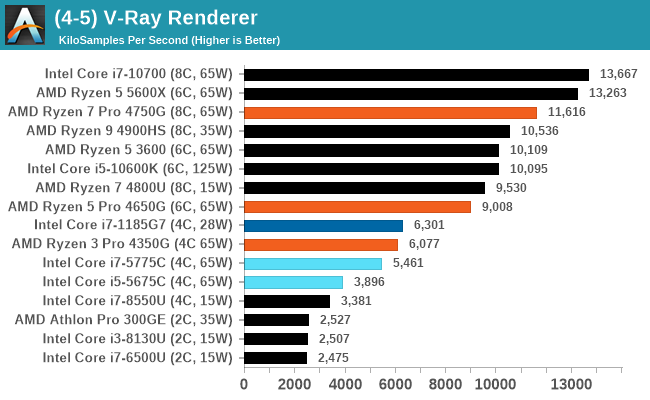
HandBrake 1.32: Link
Handbrake is a favored tool for transcoding, with the later versions using copious amounts of newer APIs to take advantage of co-processors, like GPUs. It is available on Windows via an interface or can be accessed through the command-line, with the latter making our testing easier, with a redirection operator for the console output. We take the compiled version of this 16-minute YouTube video about Russian CPUs at 1080p30 h264 and convert into a 480p30 ‘Discord’ format.
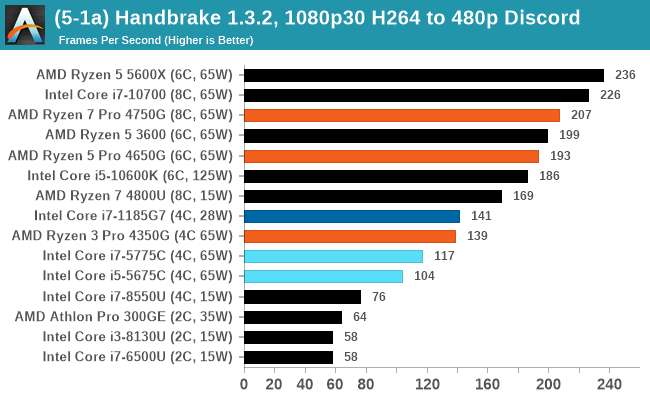
7-Zip 1900: Link
The first compression benchmark tool we use is the open-source 7-zip, which typically offers good scaling across multiple cores. 7-zip is the compression tool most cited by readers as one they would rather see benchmarks on, and the program includes a built-in benchmark tool for both compression and decompression.
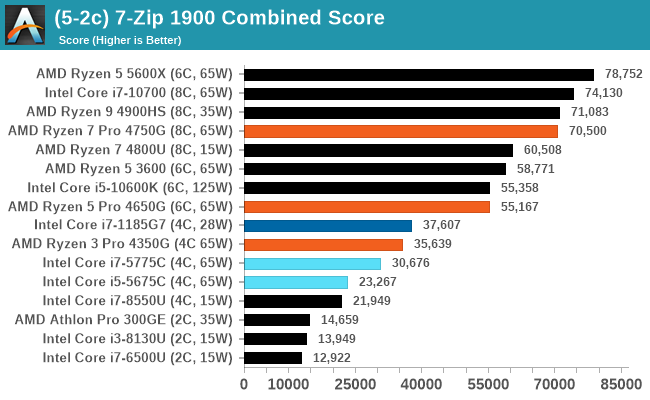
AES Encoding
Algorithms using AES coding have spread far and wide as a ubiquitous tool for encryption. Again, this is another CPU limited test, and modern CPUs have special AES pathways to accelerate their performance. We often see scaling in both frequency and cores with this benchmark. We use the latest version of TrueCrypt and run its benchmark mode over 1GB of in-DRAM data. Results shown are the GB/s average of encryption and decryption.
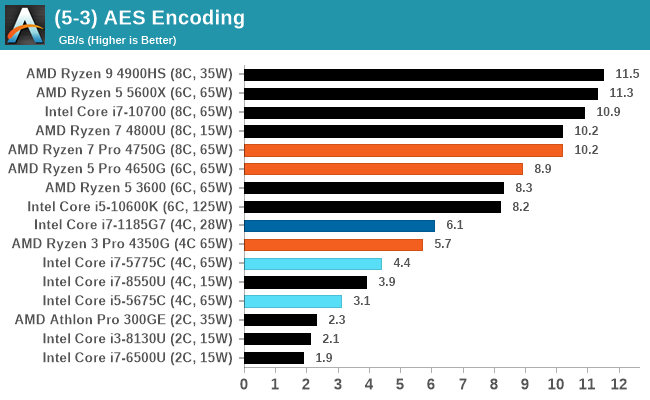
WinRAR 5.90: Link
For the 2020 test suite, we move to the latest version of WinRAR in our compression test. WinRAR in some quarters is more user friendly that 7-Zip, hence its inclusion. Rather than use a benchmark mode as we did with 7-Zip, here we take a set of files representative of a generic stack – a micture mixture of compressible and incompressible formats
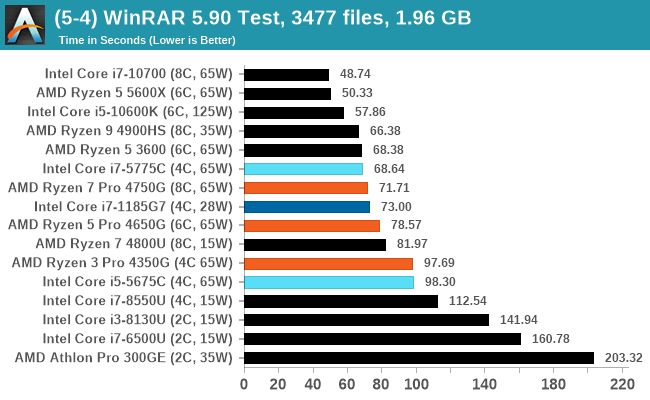
Mozilla Kraken 1.1
Kraken is a 2010 benchmark from Mozilla and does a series of JavaScript tests. These tests are a little more involved than previous tests, looking at artificial intelligence, audio manipulation, image manipulation, json parsing, and cryptographic functions. The benchmark starts with an initial download of data for the audio and imaging, and then runs through 10 times giving a timed result.
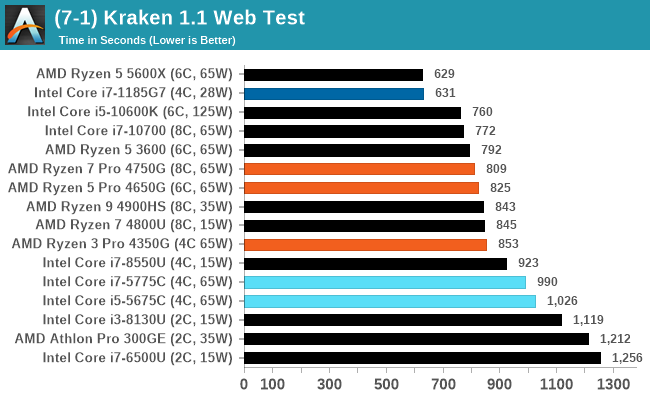
Google Octane 2.0
Our second web test is also JavaScript based, but uses a lot more variation of newer JS techniques, such as object-oriented programming, kernel simulation, object creation/destruction, garbage collection, array manipulations, compiler latency and code execution.

Speedometer 2: JavaScript Frameworks
Our newest web test is Speedometer 2, which is a test over a series of JavaScript frameworks to do three simple things: built a list, enable each item in the list, and remove the list. All the frameworks implement the same visual cues, but obviously apply them from different coding angles.
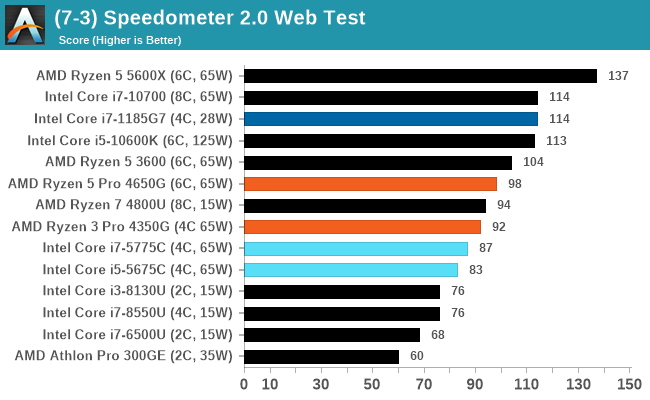










104 Comments
View All Comments
RSAUser - Wednesday, December 16, 2020 - link
Issues with this review:Missing 720p which is the most common gaming resolution for chips like these.
No check/attempt at any form of memory overclock/seeing if there's an easy one-click option and using it as a comparison point as well, since IGPU are all memory sensitive.
No frame time graph, average FPS is not even close to the whole story if there are frame drops, and at most of these averages I'd expect them to at times drop substantially.
Rudde - Wednesday, December 16, 2020 - link
If they'd overclock ram on one system, they'd have to do it on all systems. They are currently testing them at manufacturer clocks for the cpu, ram and gpu. Overclocking deserves its own article, but I'm afraid it'd require too much time to do with every processor in #CpuOverloadlinuxgeex - Wednesday, December 16, 2020 - link
It's about revealing the performance characteristics of the APU when either the CPU is the bottleneck (low resolution) or when the GPU is the bottleneck (high resolution) and then compare those limitations to the field so you can see how these APUs perform at those extremes. It's not about "let's see if we can squeeze a playable game out of this".TelstarTOS - Wednesday, December 16, 2020 - link
Average CPUs and bad APUs. Anything that performs worse than a 1650 is useless for gaming.foxalopex - Wednesday, December 16, 2020 - link
I actually recently picked up a Ryzen 5 Pro 3400GE from the aliexpress market. For a 35 watt chip with ECC support and built in GPU it makes an absolutely awesome little Linux server. I'm planning on adding a discrete GPU using PCI Passthrough to make up for graphics performance.zamroni - Wednesday, December 16, 2020 - link
Desktop doesn't need on die integrated gpu.Intel kabylake g design, which has Radeon die in cpu package, is actually better for desktop
schujj07 - Wednesday, December 16, 2020 - link
I do wonder how much of the Tiger Lakes advantages in the iGPU tests that it wins deals more with having 33% more RAM bandwidth.cbm80 - Wednesday, December 16, 2020 - link
"This means that the only company taking socketed desktop graphics seriously right now is AMD..."This is a strange statement given that AMD's integrated graphics offerings are a generation behind non-integrated, and the ones you can actually buy are two generations behind and have limited motherboard support.
Leeea - Wednesday, December 16, 2020 - link
I see Anandtech is continuing the moronic policy of using JEDEC memory speeds.At least enable XMP!
xMetaRidley - Thursday, December 17, 2020 - link
Seriously, that is incredibly stupid. Anyone running jedec has UNKNOWINGLY misconfigured their system. Why is a tech review site afraid to go into the BIOS and set the ram speed properly. It probably fell back to 2133mhz with ridiculous timings. Considering that Zen is sensitive to memory latency it makes the entire review worse than worthless.It would be like benchmarking a router's WAN performance by hooking it up to a 1.5mbps DSL modem then saying "we feel this benchmark is appropriate because much of the rural US is limited to this speed"